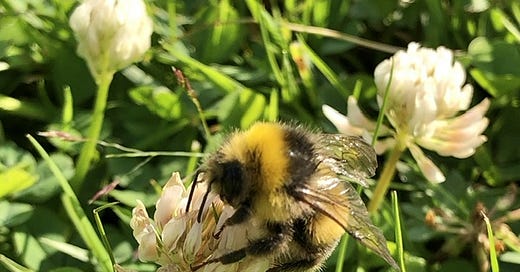A few weekends ago I was walking the dogs in our local town through a residential area. As we approached one particular property the youngest dog started barking a warning. It wasn’t immediately obvious what she was perturbed by but as we neared I could see a person crouched close to the ground spraying what looked like herbicide on “weeds” that were growing on the drive. Fair enough, I thought of the barking. Sad that this poison was being used at all, but to add to the injury, it was a very blustery day to boot. Terrible conditions to be applying such noxious stuff. It reminded me that it was quite boggling really - the fact we can buy these toxic chemicals along with our groceries, and freely squirt them about without a care or thought for what we are actually doing and how.
Our biodiversity is in crisis and if there was ever a time to consider how we garden and be mindful of not contributing to its destruction, it is surely now. If we care about our environment and the health of the ecology of our gardens and beyond, why would we want to be spreading these poisons around unnecessarily?
The UK is among the most nature-depleted countries in the world. We have lost almost half of our biodiversity since the industrial revolution, more than almost anywhere else in western Europe and the most of all the G7 nations. According to a 2021 study by scientists at London’s Natural History Museum, the UK is consistently in the bottom 10% of nations in terms of biodiversity intactness. Our planet’s health depends on insects and yet 41% of the world’s insect species are threatened with extinction.
Against this backdrop, it seems ludicrous that we can buy and use these poisons, which can affect all the wildlife in our gardens from bees and other insect pollinators to birds, bats, frogs, toads and hedgehogs. Not to mention the evidence that glyphosate (a common weed killer and the chemical found in Roundup) may be carcinogenic and adversely affect human health.
You can learn more about pesticides and the issues over at Pesticide Action Network UK, a charity that works to influence regulations and policies related to pesticides, seeks to reduce pesticide usage and protect the UK’s pesticides standards. There is a wealth of information on their website.
PAN UK also have a campaign to call on UK supermarkets to remove pesticides from their shelves and have made it easy for us to send an email to our supermarkets to request they do this. You can find the form here.
Gardener and author, Jack Wallington, is petitioning the government to ban the sale of non-organic pesticides to the general public. It has garnered encouraging support and you can add your name to it here.
Pesticides on dogs
If, like me, you are also a dog owner, did you realise that many of the traditional parasite prevention medications (whether tablet form or spot-on application) that we are sold and encouraged to use, contain pesticides and chemicals that can cause risk to the health of animals and the environment? In fact, some of the systemic insecticides used in prevention treatments have been banned for use in agriculture because of their impact on the environment.
I admit I used to use parasite prevention regularly and would diligently follow the schedule when I first got a dog, before I stopped to think about what I was doing, what these products actually contained and whether I really needed to be using them in the manner I was. These pesticides that we put on or in our dogs enter their bloodstream and organs, they sit on/under their skin (and can end up on our own skin), they shed into the environment and can end up in our waterways too. All pretty grim stuff. This recent podcast episode, “Thinking Holistically about Pesky Parasites and Your Dog”, from Tom Mitchell and Lauren Langman of AbsoluteDogs is a useful listen if you are new to this and would like to find out more.





Hi
Hope all is well.
Your logo interests me because it shows the function of the radicle. I understand that seeds in most if not all cases are raised up soon afther the radicle has completed its essential job of finding both stability and water and after which using then to strengthen the upper radicle or stem so that it can do its job of strenthening the cotyledons to produce their cotyledonary leaves, being the seed's two structural halves becoming the seed's first leaves, after which they assisit in the organism's subsequent production of two "true" leaves, being pepper, tomato, imaptiend or petunia leaves and so forth.
So I ask you why you name yourself, "Radicle", but then show a composite type logo of the seed's later stage of producing what seem to be a generic set of normal leaves. Why not show the radicle jack-knifinng the seed upwards while it does the primary work of "stage one" which is not to produce leaves, but to produce roots, thus its name.
I think it's impoortant to tell people seeds don't "grow seedlings". The first thing they do is go down intoi the earth to rise up to the sky. When I tell poeple that, they are surprised. Bit like how they're blown away when I tell people we humans are parasites. Most folks think mushrooms are like plants. But they're much more like anmials.
Just a suggestion.
Love your site.
Best,
GB/herrlueffle